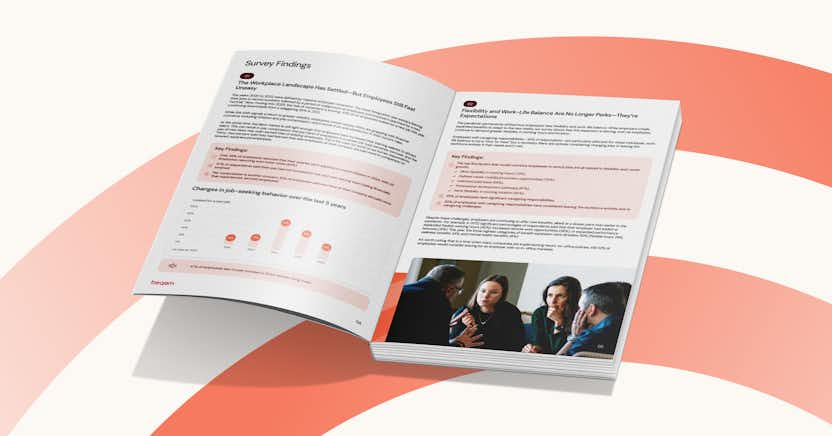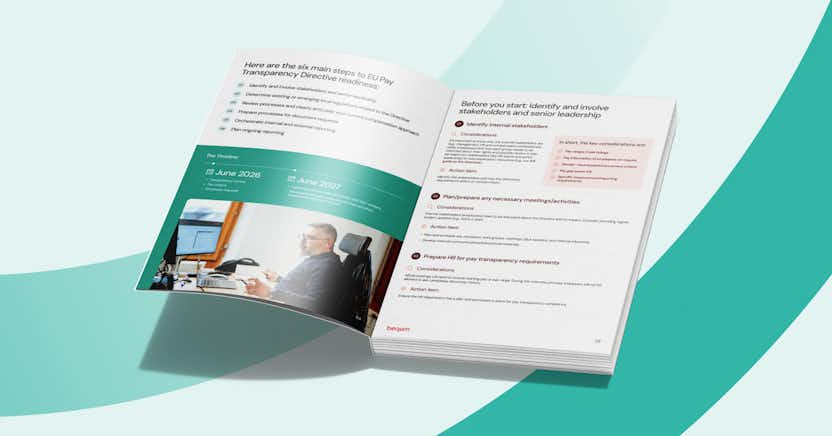Establishing Fair Compensation through HR Practices

Compensation isn’t just about the numbers. It’s about fairness. One outdated policy or overlooked bias can create pay gaps that feel more like red flags, driving talent away and leaving your team frustrated. Fair pay is the foundation of a thriving workforce. It’s also required by law in many jurisdictions, creating a need for pay compliance.
Fortunately, organizations have multiple tools to ensure fair compensation. By leveraging data analysis, providing employee training, updating recruitment processes, and using advanced HR software, they can achieve consistency, transparency, and equity in pay practices.
What is fair compensation?
Fair compensation refers to providing employees with pay that appropriately reflects their roles, skills, experience, and performance rather than being influenced by demographic factors such as age, ethnicity, and gender.
When organizations aim for fair compensation, they should focus on equality and equity.
Equality means all employees are paid the same for equal work and have access to the same opportunities, and equity means paying employees based on their individual contributions and circumstances.
A truly fair compensation system balances both equity and equality. It ensures that employees doing similar work in similar conditions are paid equally while also recognizing and accounting for their individual differences.
For example, one junior and one senior employee may complete the same hours for comparable tasks. A fair compensation system that relies solely on equal pay would ensure both employees are paid consistently. In contrast, a system that considers equity would acknowledge the senior employee’s advanced skills and experience through additional compensation, such as a higher base salary or bonuses.
The blend of equality and equity helps prevent employees from feeling undervalued for their efforts while motivating them to take on more responsibilities and progress professionally within the organization.
The benefits of fair compensation
Fair compensation leads to a range of advantages for organizations, including:
- Increased productivity: When an organization pays fairly for contributions, employees are more motivated to perform as best they can since they’ll be appropriately rewarded.
- Higher retention rates: Employees are more likely to stay at an organization that values their work and strives to promote fairness.
- Improved talent acquisition: Job seekers will be drawn to organizations offering competitive, fair compensation, particularly high-level talent that wants to be adequately rewarded for their skills and experience.
- Stronger reputation: As the demand for inclusivity increases, organizations that actively engage in fair compensation will likely stand out and be viewed as leaders in ethical business practices, improving their image and reputation.
- Minimized disputes: When compensation is transparent, clear, and based on performance, employees are less likely to feel overlooked, which reduces the likelihood of disputes regarding pay discrepancies.
- Regulatory compliance: Fair compensation helps organizations stay compliant with regulations and reduces legal risks, helping organizations avoid penalties related to discrimination or wage inequality.
Fair compensation regulations
There are different regulations, such as the CSRD, the EU Pay Transparency Directive, US EEO-1 reporting, Canadian Pay Equity legislation, the UK’s local gender pay gap reporting requirements, and France’s gender equality index — to name a few — which aim to hold organizations accountable and promote pay equity and transparency.
Organizations should be aware of and adhere to relevant regulations to avoid repercussions such as fines and disputes. For instance, many regulations require organizations to report on compensation data, such as pay gaps and salary ranges, to identify possible unfair or inequitable practices. Failing to do this can lead to various legal penalties, depending on the regulation.

EU Pay Transparency Directive Compliance Checklist
Are you ready for the EU Directive? We have put together a checklist to help you see how ready your organization is for compliance & how to prepare to be ready by 2026.
How to develop a fair compensation plan
Organizations must follow a clear plan to refine existing HR practices and introduce new ones, providing fair compensation for all employees. A fair compensation plan can be based on the following stages.
1. Gathering data
Organizations should begin performing audits and gathering data related to:
- Promotions
- Salaries
- Recruitment
- Job offers
- Job titles
- Parental leave
- Tenure
- Performance
HR departments can analyze data and highlight trends or patterns, uncovering areas that may require the organization’s attention. This analysis can also benefit from a job classification scheme, which provides a structured framework to organize and compare roles based on duties, responsibilities, and required skills.
Job classification helps ensure consistency and fairness in pay structures, so introducing it during the analysis stage allows HR to group similar roles together when analyzing data and more easily identify pay disparities or inconsistencies in the subsequent stages.
Aside from internal analysis, organizations should also assess market data, as even though fair compensation is a priority, they still need to remain competitive. Market data provides a good basis that organizations can use to align compensation with industry standards and appropriately benchmark salaries.
2. Identifying pay disparities
Organizations can identify pay disparity and inequity through the gathered data and begin investigating root causes.
For instance, major differences in the number of promotions between ethnic groups may indicate potential biases among managers, HR, or other decision-makers. Similarly, hiring significantly more male employees than female employees may signify unfair recruitment practices.
Consider all possible factors when identifying pay disparities, as they may result from multiple causes.
For example, gender pay gaps could stem from both gendered language in job listings and unequal opportunities for career advancement rather than just one or the other.
HR can conduct interviews or distribute anonymous surveys to gain more insights from employees and uncover potential reasons for unfair compensation. Some may feel they are not given adequate career advancement opportunities compared to others, which can suggest that refinements are needed in how managers assess promotions.
This process helps employees feel heard, and those dissatisfied with the current compensation process are likely to feel reassured when they see that the organization is committed to addressing issues and making meaningful improvements.
3. Setting objectives
Depending on the state of pay disparities and other findings, organizations may have specific objectives for pushing toward fair compensation.
For example, gender pay disparities will require organizations to establish objectives to support women’s equality. HR strategies to close the gender pay gap can include eliminating forced negotiations during promotion processes and offering flexible working arrangements to account for family responsibilities.
Organizations may set objectives such as setting a target to reduce the gender pay gap by a specific percentage within a defined period or establishing a goal for increasing the percentage of women in senior leadership roles.
If organizations have identified a pay disparity for employees with disabilities, they can establish a target to close the pay gap by aiming for a measurable reduction in disparities by a specific year.
Organizations should set clear, measurable objectives that HR can track, allowing for continuous improvements and providing concrete evidence of progress.
4. Establishing fair pay ranges
Fair compensation requires organizations to create standardized pay ranges, which involves aligning salaries with industry benchmarks, factoring in the cost of living, and considering employee performance.
Employees who exceed expectations should be compensated accordingly through salary adjustments or bonuses but remain within the established pay range. High-performing employees might be placed at the upper end of their pay range to recognize their contributions while maintaining fairness.
Pay ranges should also evolve with changing market conditions, including economic shifts or new trends among competitors. Regularly revisiting and assessing pay ranges ensures that compensation remains competitive and fair to keep employees satisfied and prevent them from seeking opportunities elsewhere.
5. Phasing out unfair practices
Organizations must actively identify and eliminate outdated or unfair practices that may contribute to pay disparities or inequities. These practices can unintentionally perpetuate bias or create an environment where certain groups are systematically disadvantaged.
One such practice is favoring long-term employees over newer employees with similar experience levels. This can lead to new hires with equivalent qualifications and skills being paid less despite performing the same tasks. Conversely, favoring new employees with higher starting salaries can cause pay compression, which can be considered unfair and create resentment among long-term employees who feel under-appreciated.
Another practice that can be viewed as unfair is asking for salary history during the hiring process, as this can reinforce existing pay gaps by using past salary data that may have been lower due to discrimination or unequal pay practices. Organizations should focus on offering a competitive salary based on the role, skills, and market rates rather than relying on a candidate’s previous earnings.
Negotiation bias is also a big contributor to unfair compensation. Studies have shown that individuals from certain demographic groups, such as women and people of color, are often less likely to negotiate or are penalized when they do, resulting in lower starting salaries and slower pay growth for these groups.
Organizations should standardize compensation offers and reduce reliance on negotiation, offering equitable pay based on clearly defined salary bands and ensuring that all employees are paid fairly from the start.
These and other practices can be gradually phased out to close salary gaps between certain demographic groups. While some practices can be eliminated immediately, such as preventing negotiation bias by being clear about salaries in job descriptions, others may require more gradual adjustments.
6. Adjusting compensation packages
Adjusting compensation packages to include other forms of rewards, such as performance-based bonuses, allows organizations to recognize employee contributions fairly and equitably. These bonuses should be tied to clear, measurable criteria to be awarded objectively and without discrimination.
Through this approach, organizations can motivate employees to excel and attract new talent while maintaining a fair and transparent compensation system.
One-to-one meetings can help HR assess different employee needs to offer tailored and fair compensation packages to improve equity.
For instance, female employees may value perks that aid work-life balance, such as additional PTO or remote working opportunities, while other historically disadvantaged demographic groups may value career growth opportunities, such as mentorship programs, that have not previously been offered to them.
7. Training relevant employees
Organizations should provide training for employees involved in salary and raise decisions.
These employees must understand relevant legal requirements, including documenting the reasons for pay differentials to maintain transparency and accountability. There should be clear, justifiable reasons for pay decisions, and by documenting why certain pay differences exist, organizations can ensure their compensation practices are defensible and mitigate the risk of legal disputes.
HR can also offer workplace diversity training, as when decision-makers understand how bias can impact pay, they are better equipped to recognize and correct any disparities. By challenging their own unconscious biases about diversity through workshops, seminars, or similar forms of training, these employees can make more objective decisions to aid the organization’s fair compensation efforts.
8. Utilizing HR software
Ensuring fair compensation relies heavily on data, but managing this data manually can leave room for errors and inconsistencies.
HR software can eliminate these risks and help organizations maintain fair compensation on a long-term basis while balancing other priorities, such as budget constraints and talent retention.
Pay equity software can help HR teams make more accurate pay decisions by easily identifying pay disparities and analyzing compensation across different demographics, and pay transparency software can provide visibility to ensure that pay equity and compliance goals are being met.
Similarly, compensation management software streamlines how organizations manage salaries and bonuses. HR teams can track compensation data to maintain consistency in pay practices better. For example, the software can be used to automatically adjust compensation based on predefined criteria, like market rates or performance metrics, to help eliminate subjective decisions.
Rather than relying on guesswork, organizations can also use pay intelligence software to simulate different compensation scenarios. As a result, HR teams can align pay strategies with budget constraints while maintaining fairness and ensuring that employees are paid appropriately based on their roles, skills, and performance.
Ensure fairness in compensation with beqom
There are many contributing factors to consider when it comes to fair compensation, but with specialized software like beqom’s HR solutions, achieving fairness, equality, and equity becomes much more manageable.
With data-driven insights from these solutions, organizations can reduce the risk of bias and make sure compensation decisions are based on objective criteria to ensure all employees feel seen, heard, and respected.
Ready to ensure fairness in your compensation practices? Discover how beqom’s HR solutions can help you achieve equity, transparency, and compliance.Contact us today to learn more!















